The Atacama desert is so dry and rugged, it’s been compared to Mars. Intense sun and gale-force winds punish everything—animal, vegetable, or mineral—that dares to inhabit this 1,000-mile-long high plain some 14,000-18,000 feet above sea level. Rocks, sand, and salt dominate the landscape, with only patches of dry grass and a few centuries-old cacti clinging to life in the unlikeliest crags. Despite the Atacama’s harshness, its beauty attracts visitors from around the world. Weathered rainbow rocks, bright salt flats, pink flamingos, steaming geysers, and a sparkling blanket of stars in the night sky draw van loads of tourists from dawn until well past nightfall.
While the Atacama may be an outlier in its climate, it is not alone in its combination of harshness and beauty. Throughout our time in Chile, we’ve seen the astonishing range of how nature sculpts breathtaking artistic beauty at the same time that it presents extreme challenges for living things. We lived under the fire-breathing volcano of Pucón, where past eruptions cover the ground in an impenetrable layer of now-hardened lava. We hiked to the granite spires of Patagonia, soaked by drenching rains, chilled by howling winds, and warmed by the baking sun. We touched soaring aquamarine walls of an ancient glacier, where only one living thing with natural antifreeze in its blood is known to exist. We felt the life energy of 1,000-year-old trees whose species outlived the dinosaurs. We explored a Polynesian paradise that has lost nearly all of its trees and is so isolated, it can’t be reached by mainland creatures without a boat or plane.

And now, we find ourselves in the driest nonpolar place on Earth, where the average rainfall is 6/10 of an inch per year and the average humidity is just 22%. There is water here, we learned—it’s just underground, dripping through porous volcanic rocks, fed by the condensation of mountain fog and snowmelt. It burbles up at the bottom of canyons, where the only greenery for miles crowds close to shallow pools. In some places, steaming hot water explodes through the crusty surface of the Earth in geysers, proving that both water and hot magma lie close below. The small towns that dot the landscape must drill down into a network of underground rivers in the region for their water needs.

One of those towns, San Pedro de Atacama, is the modern-day hub, but it retains its desert roots. Adobe walls, low buildings, and shaded interior courtyards provide respite from the sun and wind. Perhaps because there’s virtually no rain, dirt roads work just fine in town and never get muddy—so nearly all of the roads off the highways remain the same packed-dirt paths that have served them well for a century. Even people who have lived here for a while have a weathered look from constant exposure to wind and sun.
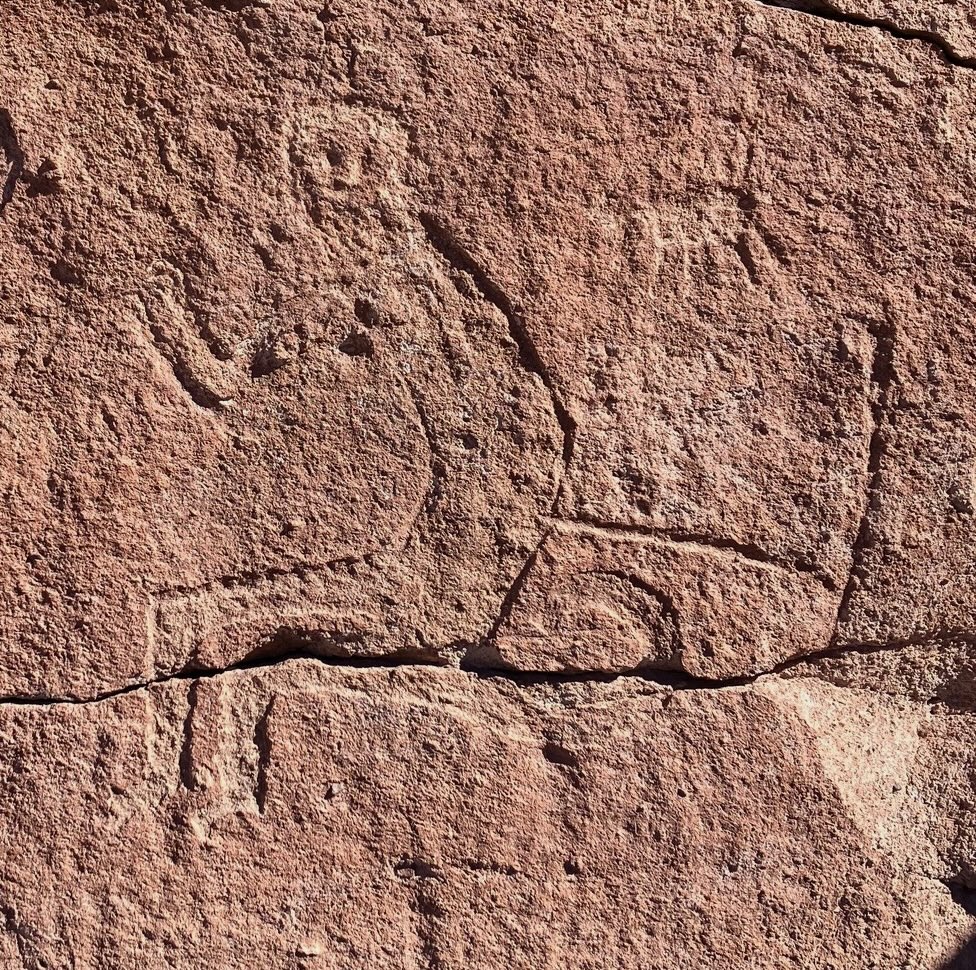
Salt, copper, and nitrate mining once drove economic subsistence in this harshest of places. Before that, trade among nomads traveling from as far away as the Brazilian jungle kept the desert alive with people. Proof of their travels still exists in the 1000-year-old petroglyphs depicting, among other iconography, an alligator and a monkey, creatures that never lived here. Now tourism is the life-blood of San Pedro. Small hostels, restaurants, souvenir and craft shops, and tour operators line the dirt streets where perhaps trading posts and ore buyers once hung their shingles.
Thanks to the advice of a friend who knows the area well, we decided to book a few days’ worth of guided tours rather than try to see the sights ourselves. Good thing: most of the best places are a couple of hours’ drive from town, many up deeply rutted roads, and the best parts can be hidden. So as much as we prefer to be self-sufficient and unhindered by groups of fellow tourists, in this case we saw and learned so much more than we would have on our own. Oh, and we also enjoyed riding rather than driving and being fed rather than packing sandwiches for a change.
Despite being part of the same desert, each site was unique.
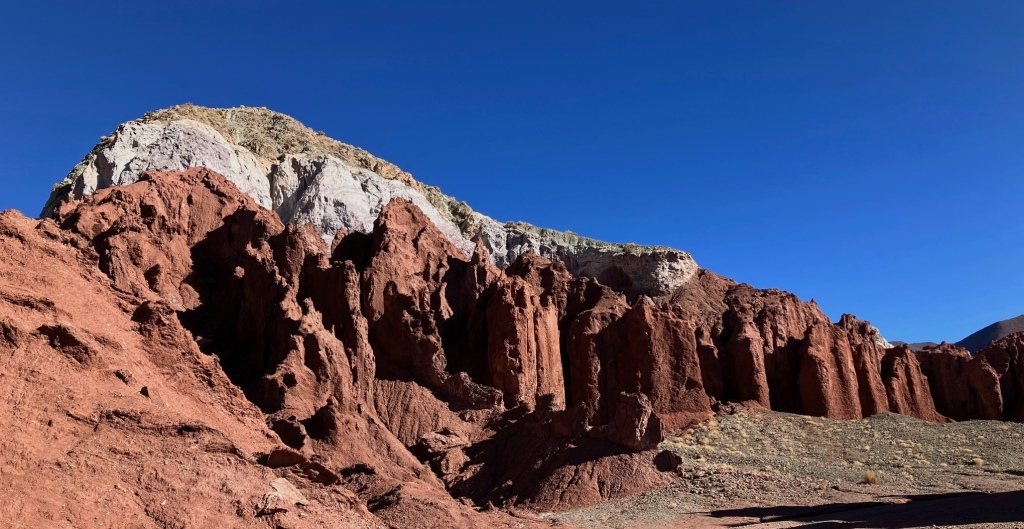
Valle del Arcoiris (Rainbow Valley) is aptly named for its stunning red, green, and white layered hills. The green rocks in particular fascinated us; they are not, in fact, oxidized copper, which has been mined in other parts of the desert for hundreds of years, but not here.
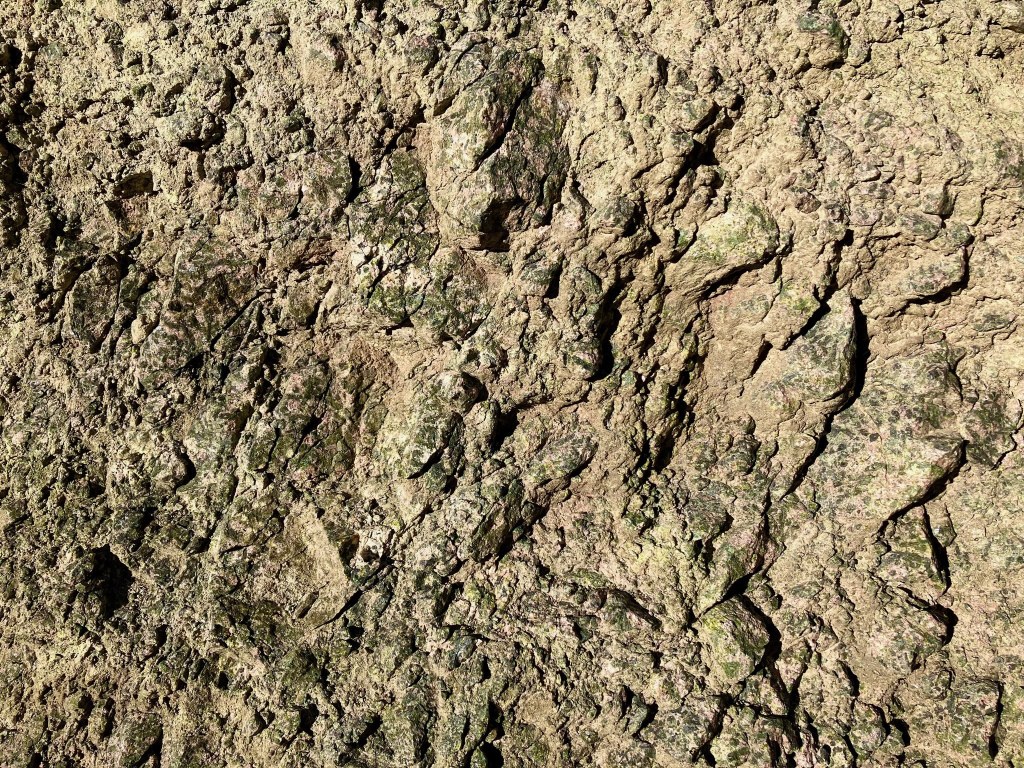
This green comes from deep underground, where magma is made of magnesium and iron, which bonded with other elements and interacted with oxygen to turn green when it reached the surface millions of years ago. (For a great description of the geological process, check out How the Rainbow Valley Got Its Colors.)
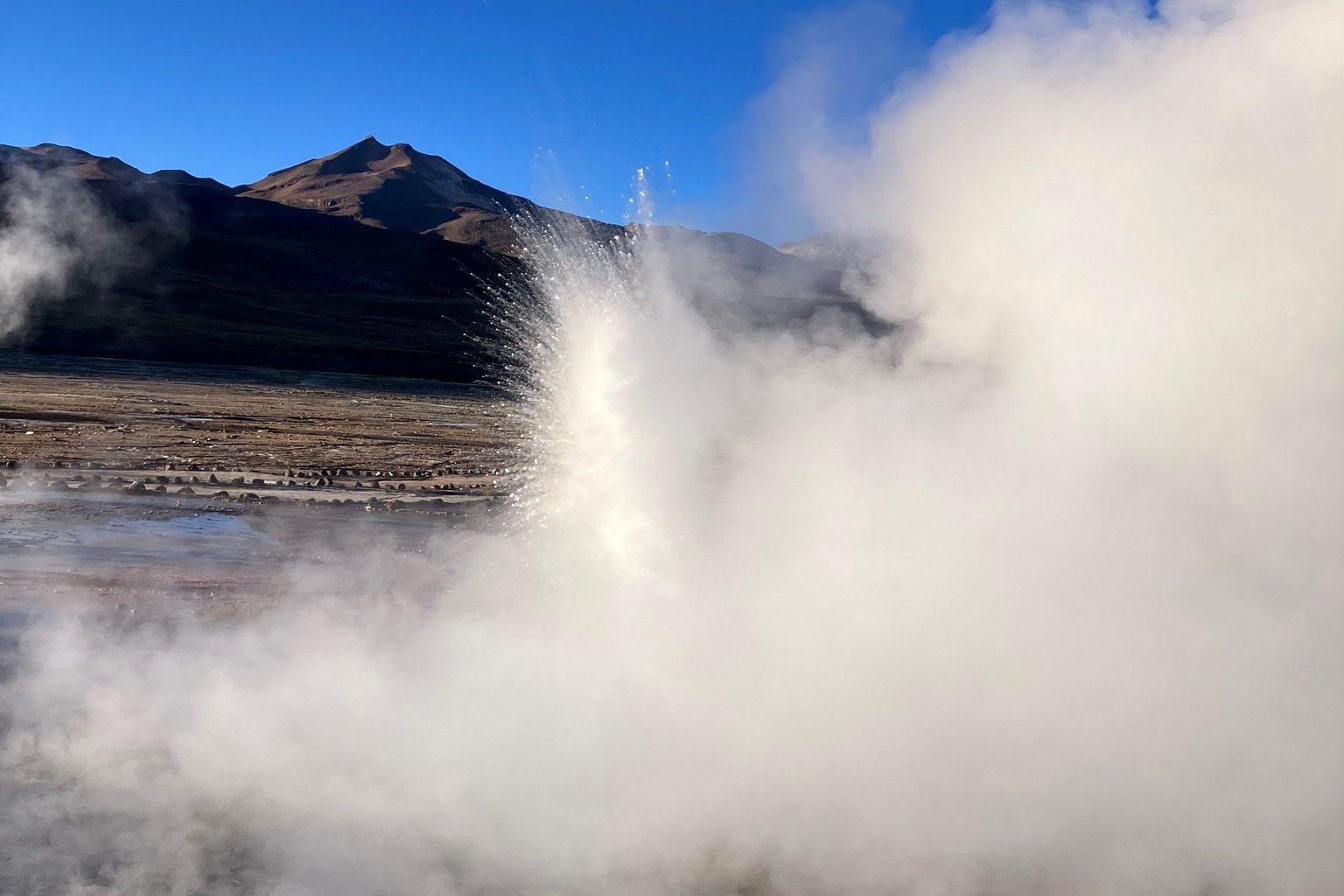
Seeing the geysers of El Tatio (from an extinct indigenous language, perhaps meaning “grandfather”; “oven”; or “burnt”) at dawn was surreal, with the sun’s angled rays illuminating steam plumes drifting across a wide volcanic valley. Boiling water bubbles up through a crust of volcanic rock so thin we felt we might fall through if we jumped and landed hard enough.

El Valle de la Luna (Valley of the Moon), with massive sand dunes and stone sculptures carved by the wind, was sprinkled with white when we saw it. Apparently a trace amount of rain had evaporated on the surface a few days earlier, causing salt crystals to grow and give the appearance of a dusting of snow. Despite being named for its similarities to the Moon, NASA used this valley to simulate the surface of Mars when testing its rovers.

Piedras Rojas (Red Rocks) is a frigid, windswept high-altitude rocky basin with rounded rocks that look like rust-colored, melted wax and a shallow, blue-green salt lake that looks like a giant, spilled margarita (or maybe that was just to me…).

The Atacama Salt Flats and nearby salty lakes are one of the only places in the world where three types of flamingos gather to eat tiny brine shrimp. One, the Chilean Flamingo, does an inimitable dance to stir up the water, daintily dabbing one foot then the next up and down.
Elsewhere we saw fields of wind farms and solar panels, a forward-thinking development given the prevalence of sun and wind, and one that contributes to Chile’s desire to become a world leader in renewable energy. On the other hand, we also saw trash, and lots of it, whether from being blown across the plains or just being dumped by the side of the road. The desert is infamous in some circles for its mountain of discarded clothes, which we didn’t see but have read about in National Geographic. Apparently clothing from all of the world’s top brands—much of it returned to online shopping vendors and never restocked—ends up in piles here because, well, how else can landowners monetize such a barren, remote place that is still close to a port? Other parts of the desert were used for even more nefarious purposes during Chile’s dictatorship years—the remains of “disappeared” dissidents have been found here, finally validating families’ worst fears.
Harshness is everywhere, not just in Chile. So is beauty. Somehow it’s their combination into a swirling, breath-taking whole that makes Chile stand out. What will linger for me about our time here is the beauty and the harshness together; extremes that combine to tell a story. It is a country that is both the narrowest and one of the longest countries in the world. It is a country that rises from sea level to 18,000 feet in less than 200 miles. It is a country that dips its toes in the freezing waters of Antarctica on one end and squints its eyes in the punishing sun of a high-altitude desert at the other. It is a country that has been shaped by crashing Pacific waves, deadly lava flows, shattering earthquakes, and crushing Andean glaciers. It seems only fitting that we end our visit in the Atacama, where the stunning combination of harshness and beauty is perhaps the most extreme in all of Chile.
| Note: We will be taking a few weeks off while we visit with family and friends, get settled for the summer, and plan for next year. After sleeping in 50 different beds since we left our cabin, we’re looking forward to staying put for a spell. We’ll be sure to post about our plans as soon as we have them! |
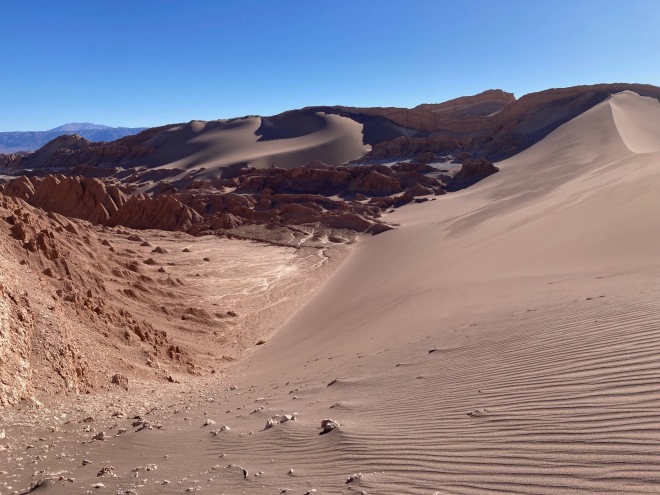
this is a fabulous description of a remarkable place on our planet. Thank you again for all the discoveries you are sharing with your readers. I am looking forward to reading about your next destinations and how you decided where you will be in 2025.
LikeLiked by 1 person
I’m glad you enjoyed your time in the Atacama Desert and San Pedro. We explored the area in our truck camper for a few weeks and the dust did get old after a while, thanks to the winds. We skipped the hot springs and some other sites, because of their high entrance fees, but we still enjoyed our time in Northern and Central Chile. Have a nice and relaxing summer!
LikeLike
Thanks Liesbet! Where will you be next?
LikeLiked by 1 person
Hi Al,
We are currently in MA visiting my husband’s family, our friends, and doctors for three weeks. Then, two months in Belgium to hang out with my family and rest. The camper is stored in Buenos Aires. This is our first multiple-month break from the road (and water) in 20 years, other than Covid. We need some comfort and ease in our lives right now. 🙂
LikeLike